Early ganseys in Norfolk
This page is the product of a trawl through the collections of the Cromer, Sheringham and Norwich Castle Museums for evidence illuminating the wearing of ganseys in Norfolk. The photographs are unequivocal but can only take us back to the mid-nineteenth century at best. Before that we have to rely on artists and the pictures need to be assessed, as the figures are often incidental and are only there to add romance and aid the composition, so they are often not detailed and may not be accurate.
Here, presented in chronological order, is the evidence I have found so far, starting with the early 20th century and reaching back to Georgian times.
1900s
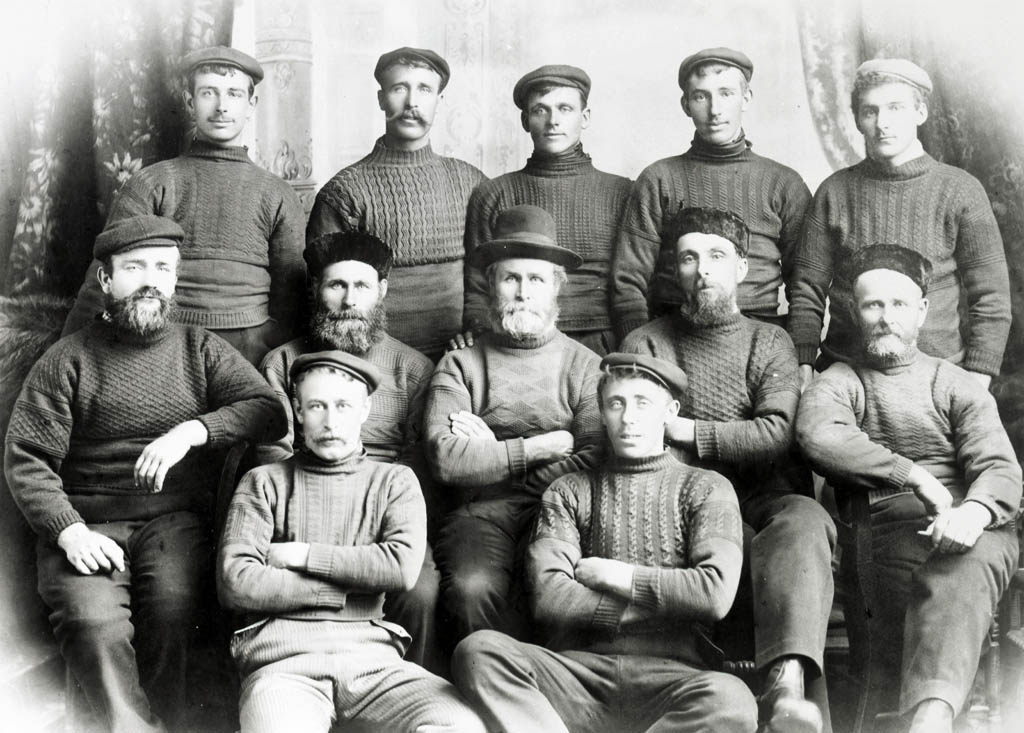
By the closing years of the 19th century fishermen wore their ganseys as outer garments with pride. Necks were tight and some ganseys had buttons on the left of the neck in the manner of some Scottish ones. Undergarments were not visible. Neckerchiefs (roppers) helped to seal the neck against draughts. Ganseys were short and high-waisted whole-fall trousers with roomy seats were universal. In Sheringham at least the vertical patterns (usually of two alternating motifs, occasionally three) were popular. Waistcoats were no longer worn over ganseys but tanned slops (cotton or sailcloth t-shaped garments covering the upper body) protected the gansey while working and kept out the wind. Sleeves were often short or worn rolled up. These types of gansey remained popular for more than half a century but gradually declined from around the 1950s as new clothing designs and materials became available.
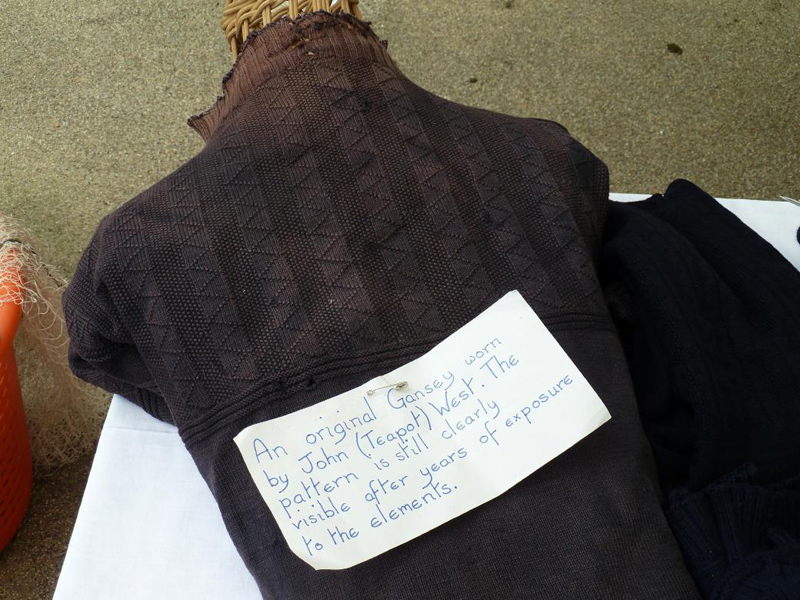
One of the oldest extant Sheringham ganseys, belonging originally to John 'Teapot' West and proudly displayed by Ann and Lennie 'Teapot' West at the Cromer and Sheringham Crab and Lobster Festival in 2011. Lightning and hailstones, knitted by Rachel West about 1915.
1890s
 By the 1890s the style of dress had changed - dropping the old-fashioned waistcoats over the top of ganseys, visible shirts and the gansey had become a badge of office worn by fishermen all around the coast of Britain and the North Sea and beyond. A great variety of patterns were knitted by local women for their loved ones and this remained the norm until the 1950s, although die-hard fishermen wore ganseys and whole-fall trousers after the war. Lennie Teapot West still wore them when I knew him in the 1980s, well over 100 years after they came into fashion. To this day a few fishermen in North Norfolk have velvet on the back of the collars of their best jackets; a fashion that came in in late Victorian or Edwardian times.
By the 1890s the style of dress had changed - dropping the old-fashioned waistcoats over the top of ganseys, visible shirts and the gansey had become a badge of office worn by fishermen all around the coast of Britain and the North Sea and beyond. A great variety of patterns were knitted by local women for their loved ones and this remained the norm until the 1950s, although die-hard fishermen wore ganseys and whole-fall trousers after the war. Lennie Teapot West still wore them when I knew him in the 1980s, well over 100 years after they came into fashion. To this day a few fishermen in North Norfolk have velvet on the back of the collars of their best jackets; a fashion that came in in late Victorian or Edwardian times.
This style of home-knit gansey appears to have developed in the second half of the nineteenth century, apparently through influences picked from the mixing with Yorkshire and Scottish communities during the herring fishing season and through migration between the North Norfolk and ports such as Grimsby and also known inter-marriage between Norfolk fishermen and Yorkshire women.
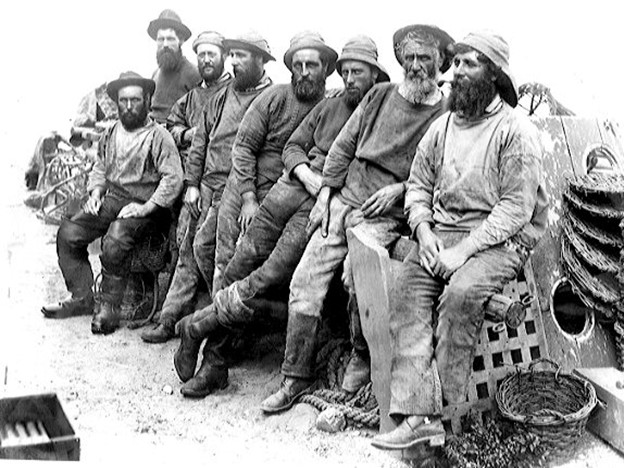
1880s
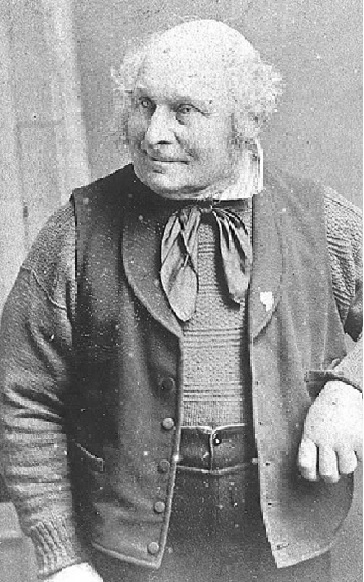 Billy Clubfoot Mayes, Cromer fisherman in about the early 1880s. He wears a shirt beneath his gansey with the collar up and a knotted neckerchief, possibly black, hanging outside. His gansey is tucked inside his whole-fall trousers and a new-looking moleskin waistcoat over that. The gansey pattern is a ubiquitous one of seed stitch in horizontal panels that could be bought from chandlers and contract knitted somewhere like Polperro in Cornwall. Four panels of seed stitch are separated by four single rigs (called 'rises' in Norfolk) with perhaps two, possibly three rounds of plain between them. The tension is about 8 spi. Very similar to Gilbert Rook's gansey (see Cromer GP31) except this one is a double seed rather than a treble one. Both Billy Mayes and Gilbert Rook would be "old-timers" at this period and wore a slightly dated style of clothing.
Billy Clubfoot Mayes, Cromer fisherman in about the early 1880s. He wears a shirt beneath his gansey with the collar up and a knotted neckerchief, possibly black, hanging outside. His gansey is tucked inside his whole-fall trousers and a new-looking moleskin waistcoat over that. The gansey pattern is a ubiquitous one of seed stitch in horizontal panels that could be bought from chandlers and contract knitted somewhere like Polperro in Cornwall. Four panels of seed stitch are separated by four single rigs (called 'rises' in Norfolk) with perhaps two, possibly three rounds of plain between them. The tension is about 8 spi. Very similar to Gilbert Rook's gansey (see Cromer GP31) except this one is a double seed rather than a treble one. Both Billy Mayes and Gilbert Rook would be "old-timers" at this period and wore a slightly dated style of clothing.
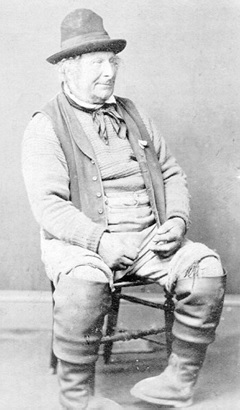 Another image of Billy Mayes, about the early 1880s. Note his specially made leather boots.
Another image of Billy Mayes, about the early 1880s. Note his specially made leather boots.
1870s
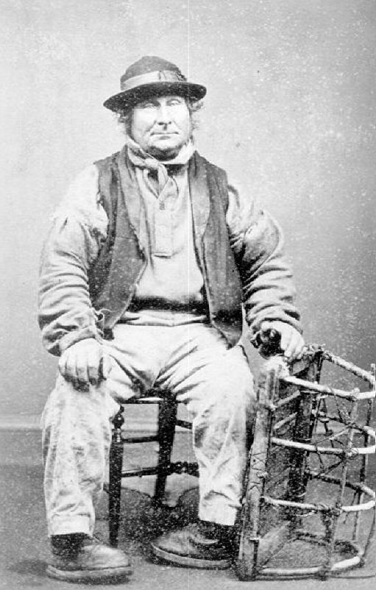 Billy Mayes with a crab pot undergoing refurbishment. He is not wearing a gansey here, looking more like a sailor than a fisherman. He wears a very thick shirt with upturned collar and buttons half way down the front, a ropper (neckerchief) is tied around the collar (rather than inside it around his neck) and over the top is a well-worn waistcoat. He is also wearing a chummy hat and trousers. The crab pot had not long before been introduced to Cromer from Yorkshire, the first one being brought back on Henry Sandford's coal boat, the "Commerce", in 1863.
Billy Mayes with a crab pot undergoing refurbishment. He is not wearing a gansey here, looking more like a sailor than a fisherman. He wears a very thick shirt with upturned collar and buttons half way down the front, a ropper (neckerchief) is tied around the collar (rather than inside it around his neck) and over the top is a well-worn waistcoat. He is also wearing a chummy hat and trousers. The crab pot had not long before been introduced to Cromer from Yorkshire, the first one being brought back on Henry Sandford's coal boat, the "Commerce", in 1863.
1860s
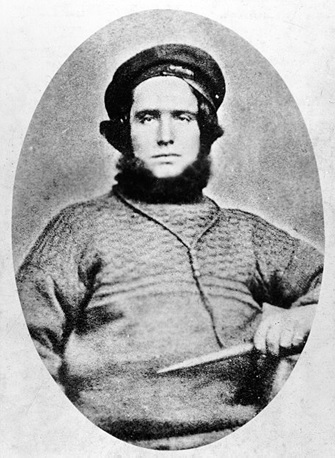 Unknown mariner. A naval or merchant navy officer, photographed in Bristol with a lanyard and a fid (rope splicing tool). About the 1860s. He wears a gansey with a basket-weave pattern on a rather short yoke and two broad 'furs' and three 'rigs' below the pattern. So, it was not just fishermen who wore ganseys, although he may have come from a fishing background. This gentleman appears in another photograph (below, top left) in civilian dress, accompanied by three equally well-dressed friends, one of whom looks like a young fisherman (bottom right) in a gansey over a shirt and a jacket on top. It looks like a wedding or a stag do.
Unknown mariner. A naval or merchant navy officer, photographed in Bristol with a lanyard and a fid (rope splicing tool). About the 1860s. He wears a gansey with a basket-weave pattern on a rather short yoke and two broad 'furs' and three 'rigs' below the pattern. So, it was not just fishermen who wore ganseys, although he may have come from a fishing background. This gentleman appears in another photograph (below, top left) in civilian dress, accompanied by three equally well-dressed friends, one of whom looks like a young fisherman (bottom right) in a gansey over a shirt and a jacket on top. It looks like a wedding or a stag do.
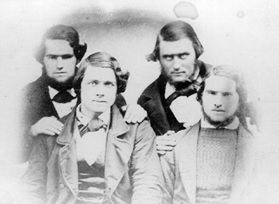
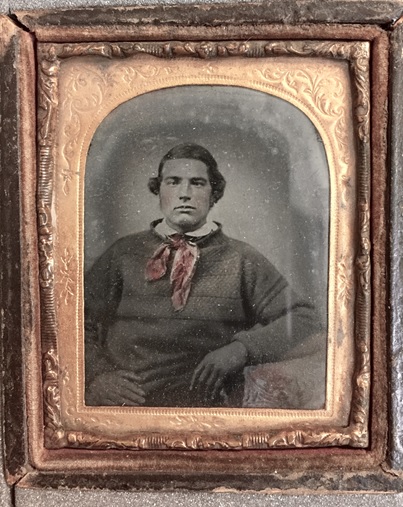 Unknown mariner. Daguerreotype (or tin type) 1850s - 1870s. Photo from Tim Groves, Sheringham Museum.
Unknown mariner. Daguerreotype (or tin type) 1850s - 1870s. Photo from Tim Groves, Sheringham Museum.
Is this the same chap as the previous photographs? Maybe not. He is clean shaven and has a squint which is not apparent in the other photographs. A loose-fitting gansey with a very wide neck sits on a shirt with a neckerchief tied around the collar. The pattern is a coarse version of seeds and bars, with four panels of a honeycomb stitch on the yoke and two rigs at the top of the arms. See the Sheringham section (GP2) for a similar honeycomb pattern.
1850s-1860s
 Top of Cromer Gangway, stereo pair. 1850s or 1860s (stereo photography became very popular after the Great Exhibition of 1851).
Top of Cromer Gangway, stereo pair. 1850s or 1860s (stereo photography became very popular after the Great Exhibition of 1851).
Three fishermen and a coastguard standing in front of a 'pinker' and leaning against a crab boat (left).
The middle fisherman wears a waistcoat over his gansey and a ropper (neckerchief) hanging outside his gansey while the right-hand fisherman is wearing braces to support his high-waisted whole-fall trousers and a ropper hangs outside his gansey too. By the end of the 19th century the roppers were tucked inside the neck of the gansey and no shirt is visible.
The fisherman on the right seems to have an upturned shirt collar coming out of his gansey and sports a beard around his jaw and throat but has shaved his moustache (cf. previous picture). These ganseys are quite loose fitting compared with later ones at Sheringham.
The gansey worn by the fisherman on the left seems to have a problem with the bottom of it rolling up (which is normally prevented by the welt). He has some champion sideburns under what appears to be a plaited straw hat that is reflecting the sunshine.
1860
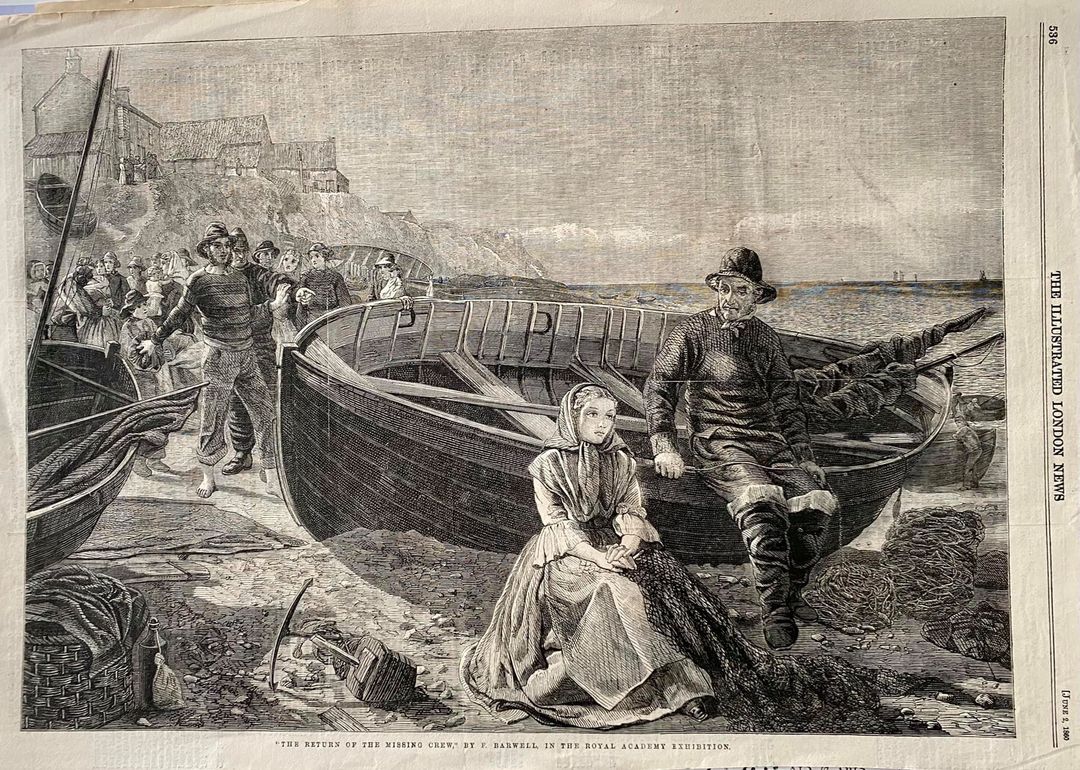
A woodcut from the Illustrated London News, 1860 depicting Sheringham beach; from a painting "Return of the missing crew" by Frederick Bacon Barwell. In the original painting we see that the ganseys were dark blue. While the fisherman on the left appears to have a universal pattern with horizontal seeds and bars, the fisherman in the boat has a gansey that hints at the Sheringham style with a vertical pattern. Without examining the painting closely we can't be sure of the detail, but it is currently in the collection of the Dallas Museum of Art, Texas (Accession no.: 2019.46.1) 105.6 x 1.51 cm, not on view.
1858
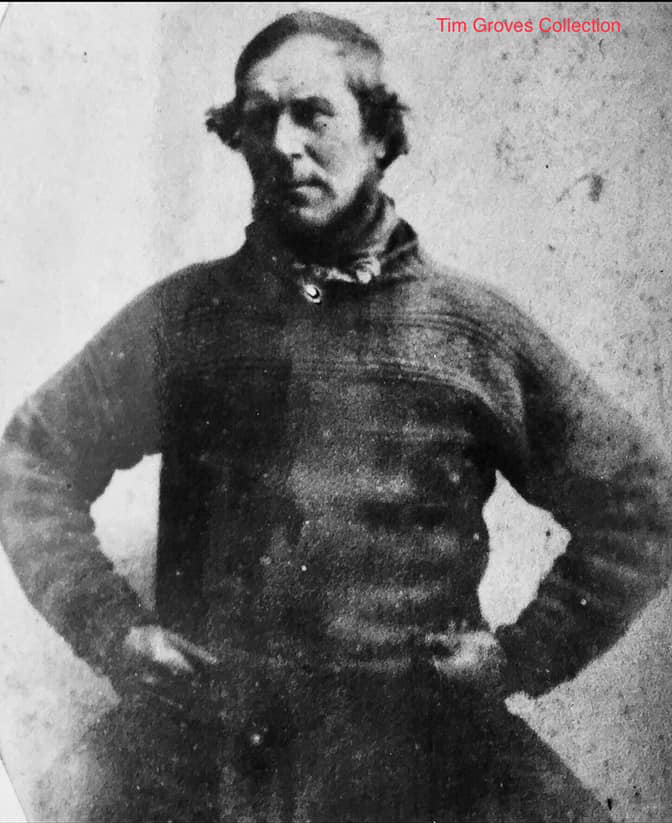
This is a contender for the oldest dated photograph of a gansey, in the world. John Grimes, Sheringham fisherman. Copied (35 mm) from a photographic print in an album belonging to the Upcher family of Sheringham Hall, dated 1858 by an annotation beside the picture. Not a Sheringham pattern but a universally available one, seeds and bars, purchased from chandlers and quite likely knitted in a place like Polperro in Cornwall.
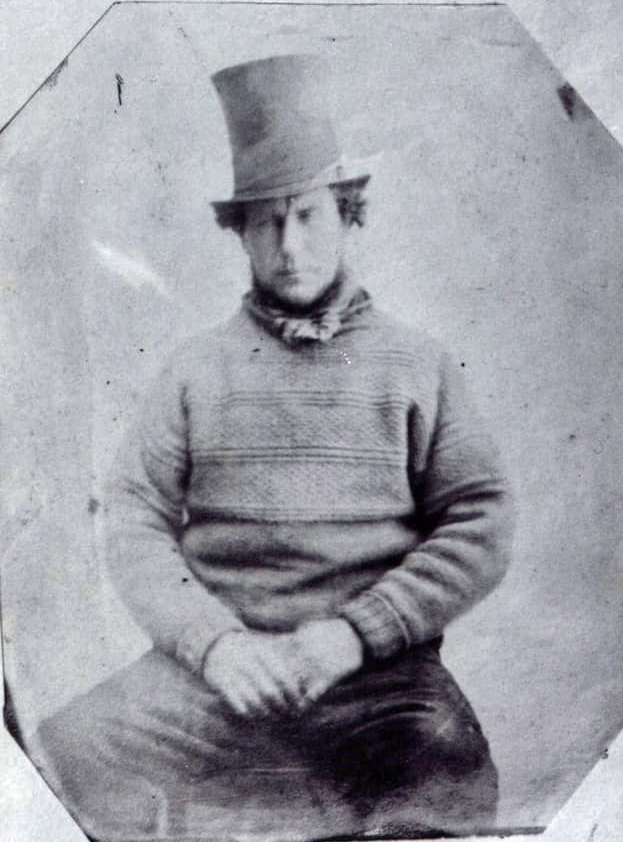 Another picture of John Grimes, in a top hat wearing a universal gansey pattern of seed stitches and bars. By numerous points of comparison I conclude that this is the same man as the photograph above and taken in the same session in 1858. Points are: the gansey pattern is the same; the lie of the neck is the same; the length of hair; the beard style; the stance on the seat; the rolled back cuffs; the number of ruckles in the gansey forearm; the background. Notwithstanding that the lower picture appears more youthful than the upper the facial features are the same but I think the identical knotting of the neckerchief is a clincher. Furthermore, by his smoothed down hair the upper man has recently been wearing a hat. The hat is almost identical to one worn by Isambard Kingdom Brunel in a famous portrait standing before the gigantic launching chains of the SS Great Britain, by Robert Howlett, dated November 1857.
Another picture of John Grimes, in a top hat wearing a universal gansey pattern of seed stitches and bars. By numerous points of comparison I conclude that this is the same man as the photograph above and taken in the same session in 1858. Points are: the gansey pattern is the same; the lie of the neck is the same; the length of hair; the beard style; the stance on the seat; the rolled back cuffs; the number of ruckles in the gansey forearm; the background. Notwithstanding that the lower picture appears more youthful than the upper the facial features are the same but I think the identical knotting of the neckerchief is a clincher. Furthermore, by his smoothed down hair the upper man has recently been wearing a hat. The hat is almost identical to one worn by Isambard Kingdom Brunel in a famous portrait standing before the gigantic launching chains of the SS Great Britain, by Robert Howlett, dated November 1857.
From the Upcher family albums in Sheringham Hall, copied with permission of the tenants. Perhaps John Grimes was an estate worker for the Upcher family as well as a fisherman. By courtesy of Tim Groves.
1847


Southwest view of the Church of Saint Peter and Saint Paul in Cromer in Norfolk (detail) by John Buckler 1847. G. Hawkins lithographer. (Author's collection)
The addition of these figures is entirely for interest, scale and to aid the composition. Although the figures are only 15 mm tall in the print they are convincingly drawn. The fishermen are wearing the old-fashioned and voluminous short slops (also known as wide-kneed breeches or petticoat breeches) and boots and what appear to be ganseys with a yoke coming halfway down the body. Breeches in one form or another had been in use since at least Elizabethan times and it is possible that the figures are romantic caricatures of fishermen rather than an accurate representation of the fishermen of Cromer in the 1840s. Never-the-less, they are wearing ganseys, so proof that ganseys existed before 1847.
1840
 Drawing, 'Fisherman' by Miles Edmund Cotman (1810-1858), charcoal and white chalk on paper, dated 3 Jun 1840. It is impossible to know if he is wearing a gansey under the top garment; perhaps he wears a shirt. It appears to be a faithful study of an actual fisherman and his clothing. Norwich Museum and Art Gallery.
Drawing, 'Fisherman' by Miles Edmund Cotman (1810-1858), charcoal and white chalk on paper, dated 3 Jun 1840. It is impossible to know if he is wearing a gansey under the top garment; perhaps he wears a shirt. It appears to be a faithful study of an actual fisherman and his clothing. Norwich Museum and Art Gallery.
1829
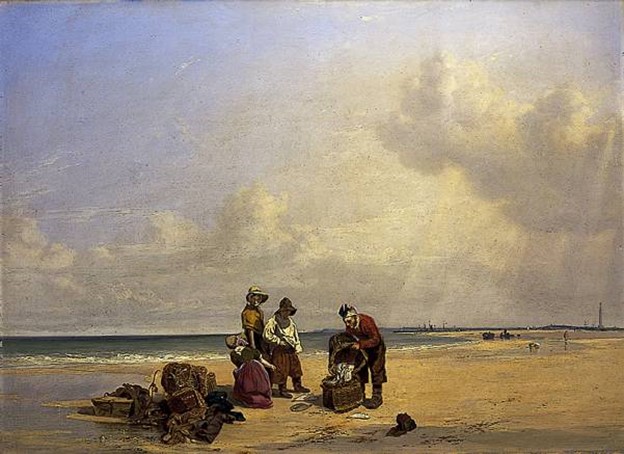
On Yarmouth Sands. 1829. A studio painting by Joseph Stannard (1797-1830) in the Norwich Castle Museum and Art Gallery features a boy wearing over-sized slops and a fisherman tipping out fish from a basket. He wears a woollen jumper which has all the hallmarks of a gansey.
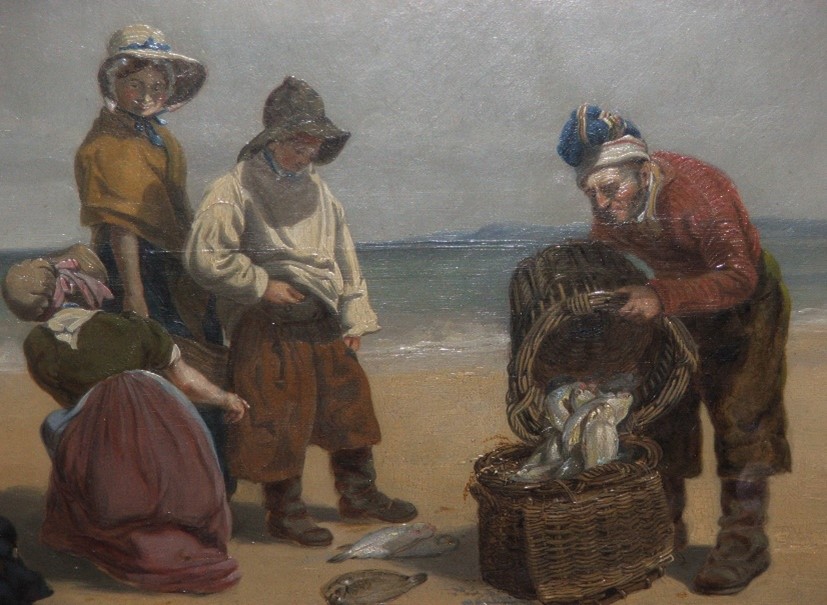
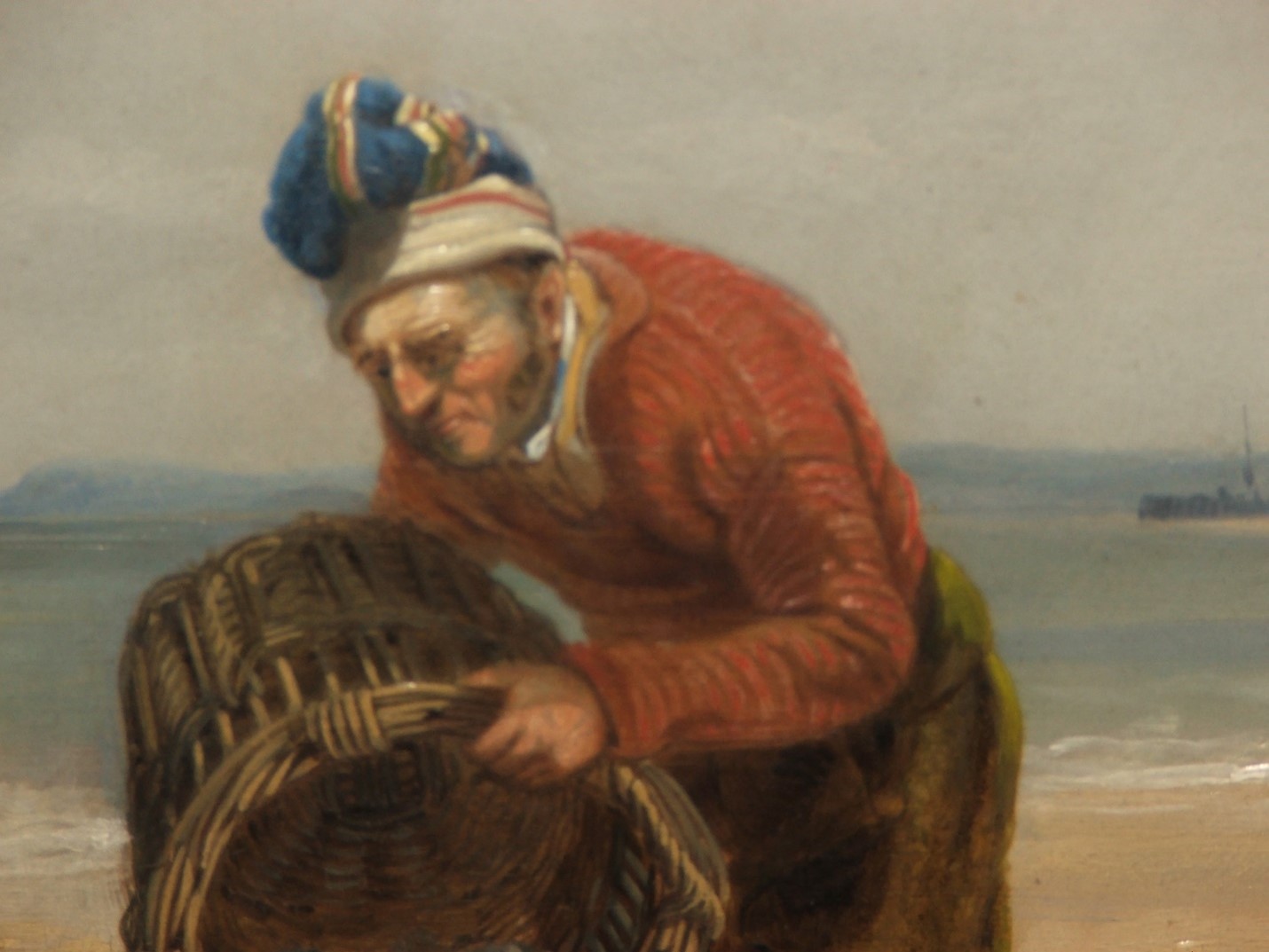
Apparently, he wears a knitted woollen garment with a raised pattern. It is grafted at the shoulder, with a shoulder strap and a stand-up collar and a white shirt can be seen beneath. The fox brown colour is perhaps surprising to our eyes but at this date they didn't knit universally in navy blue. Notwithstanding that there may be artistic license here in some of the details, I am convinced that this is a gansey. Stannard made a preparatory study of this fisherman, presumably in the field, so he must have observed the man closely. Not wanting to waste a good study sketch he used the same figure in another painting. The man with the telescope wears a similar jumper in a duller brown colour.
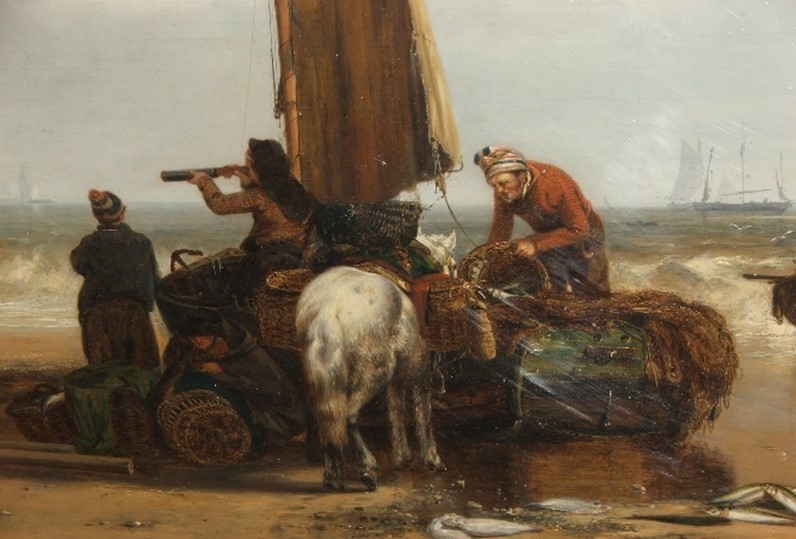
Norwich Museum and Art Gallery
1828
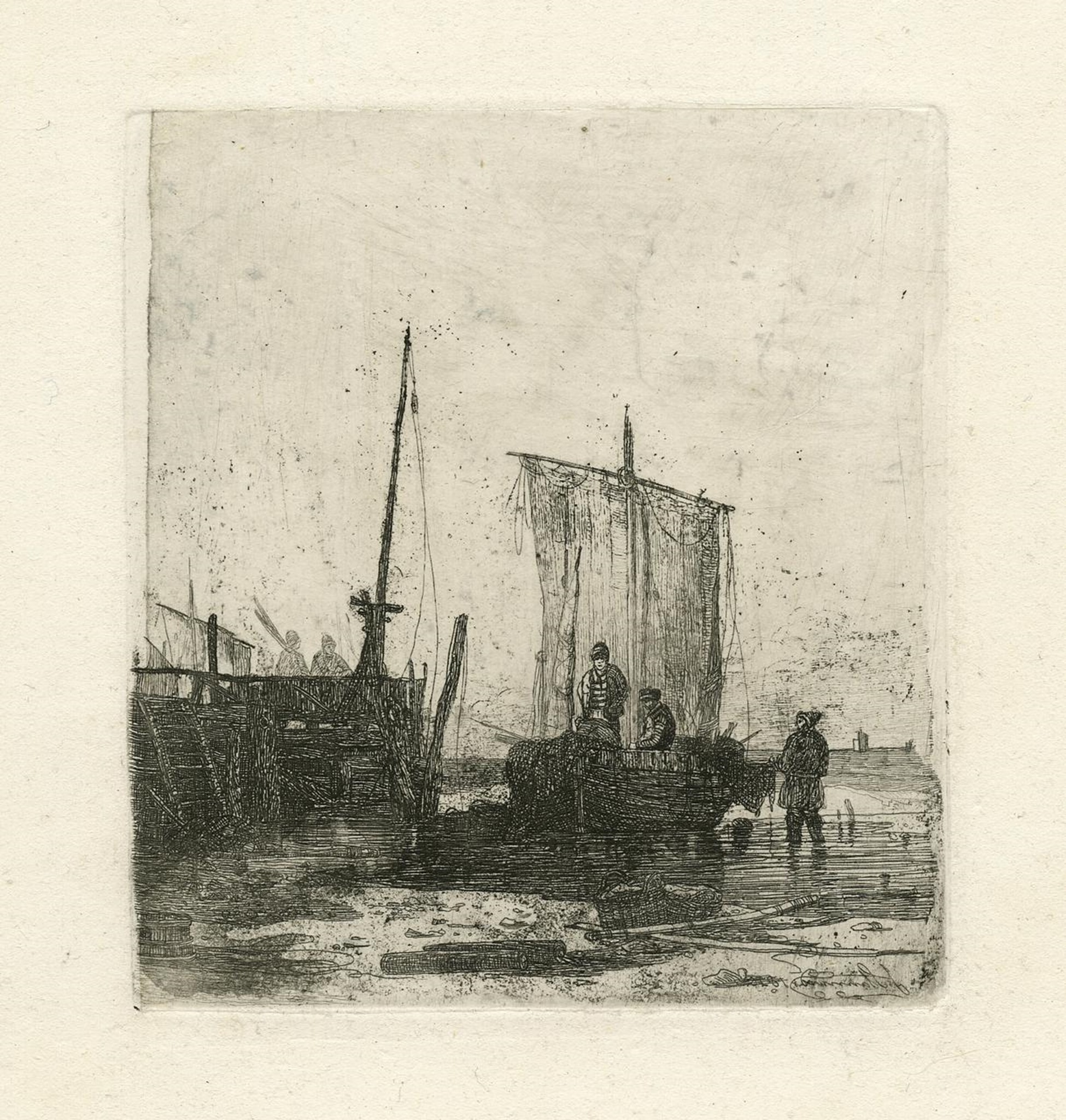
Print, 'Yarmuth Jetty' by Joseph Stannard (1797-1830), etching on paper, 1828; signed and dated in plate lower right corner in reverse 'J Stannard 1828'. The fishermen in the boat have similar looking ganseys to the character in the previous paintings. Norwich Castle Museum and Art Gallery
1824-1827
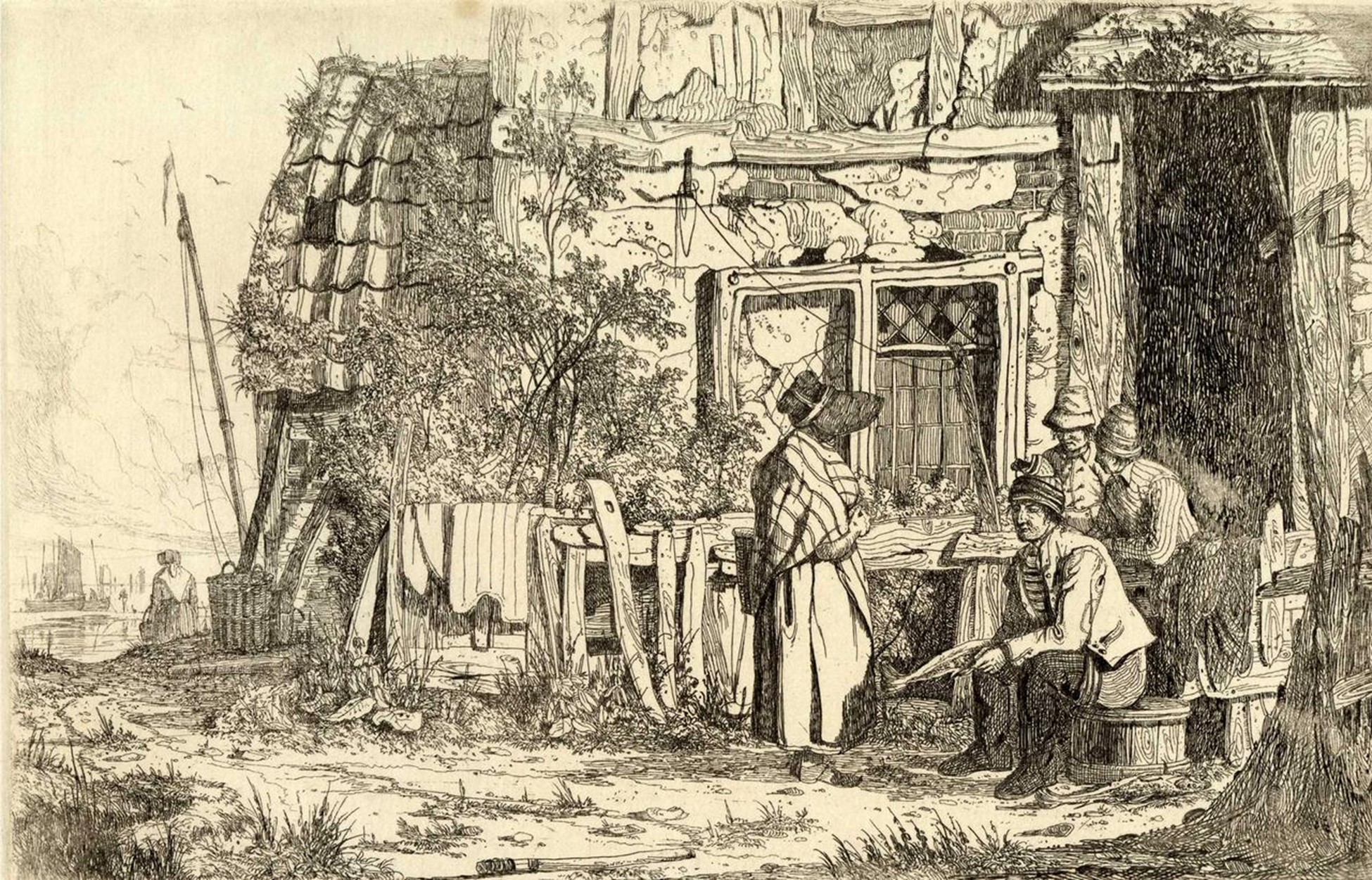
Print, 'Cottage with figures - 'At Trowse' by Joseph Stannard (1797-1830), etching on paper, 1824 to 1827. Norwich Castle Museum and Art Gallery. The seated character is holding a fish and the river isn't far away (left) so we might assume he is a fisherman. He wears thigh length water boots and a woollen hat as we have seen on other fishermen. Under his jacket he is wearing a striped garment. Is this a gansey or a Breton style jumper? We are clutching at straws.
So, this is as far back as I can find evidence of ganseys being worn in Norfolk but I fully expect they were around before the 1820s. Through the course of their evolution the gansey became more than a just a functional garment. It was practically a uniform, worn universally in fishing communities and proclaiming the wearer to be a fisherman. Woe betide the man who wore one but was not a fisherman! It was a rite of passage for a youth to get his first gansey and join the men. The knitting of them was clearly above and beyond pure necessity. It was a source of pride to wear one and their production became a labour of love. Some families fiercely protect their patterns against commercial exploitation and I have every sympathy for their point of view, so their patterns are not featured on this site, beautiful though they are.
Martin Warren, The Northfolk Project
25.8.2021